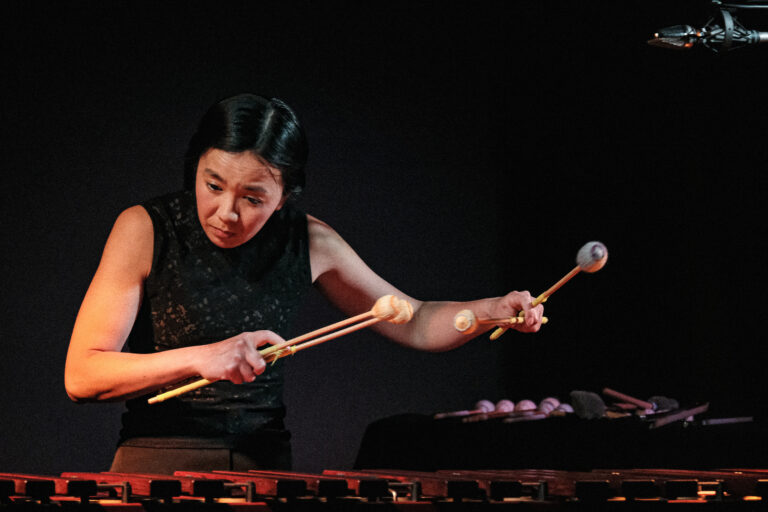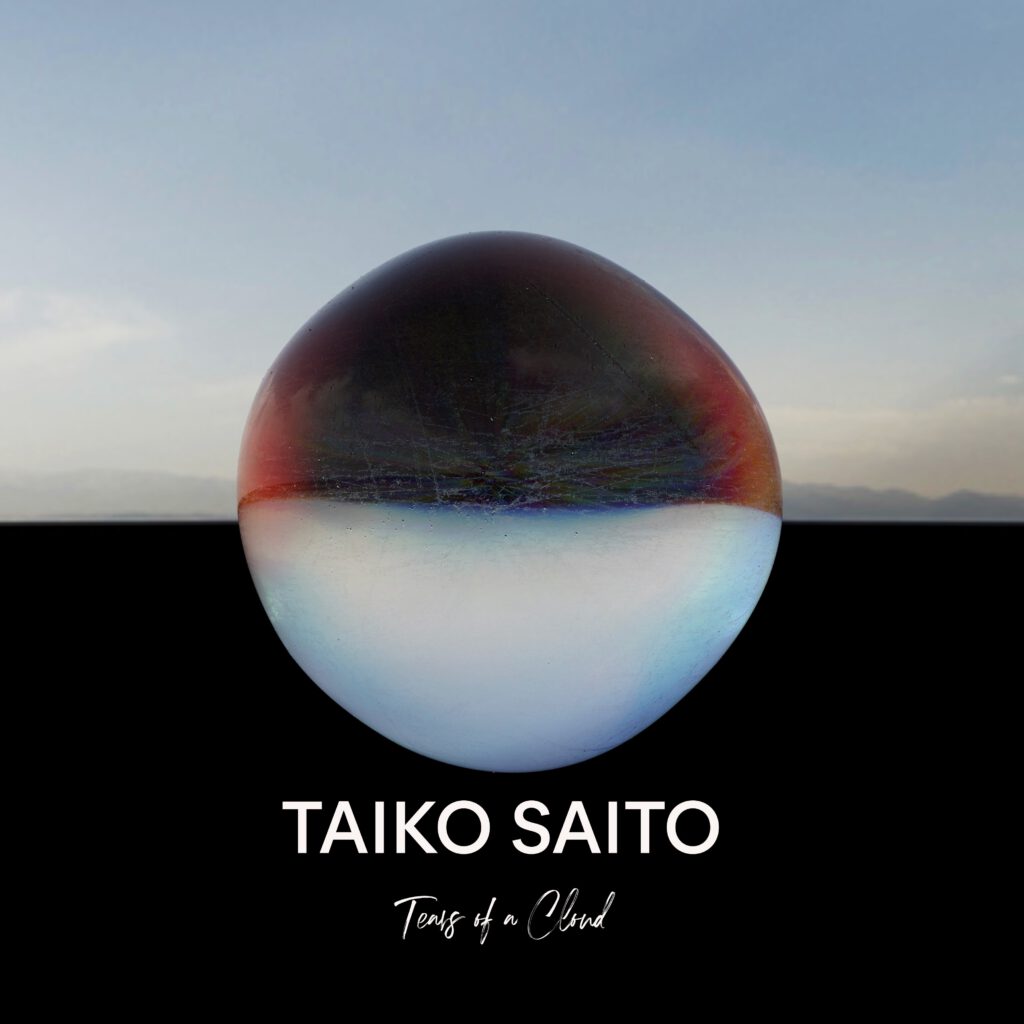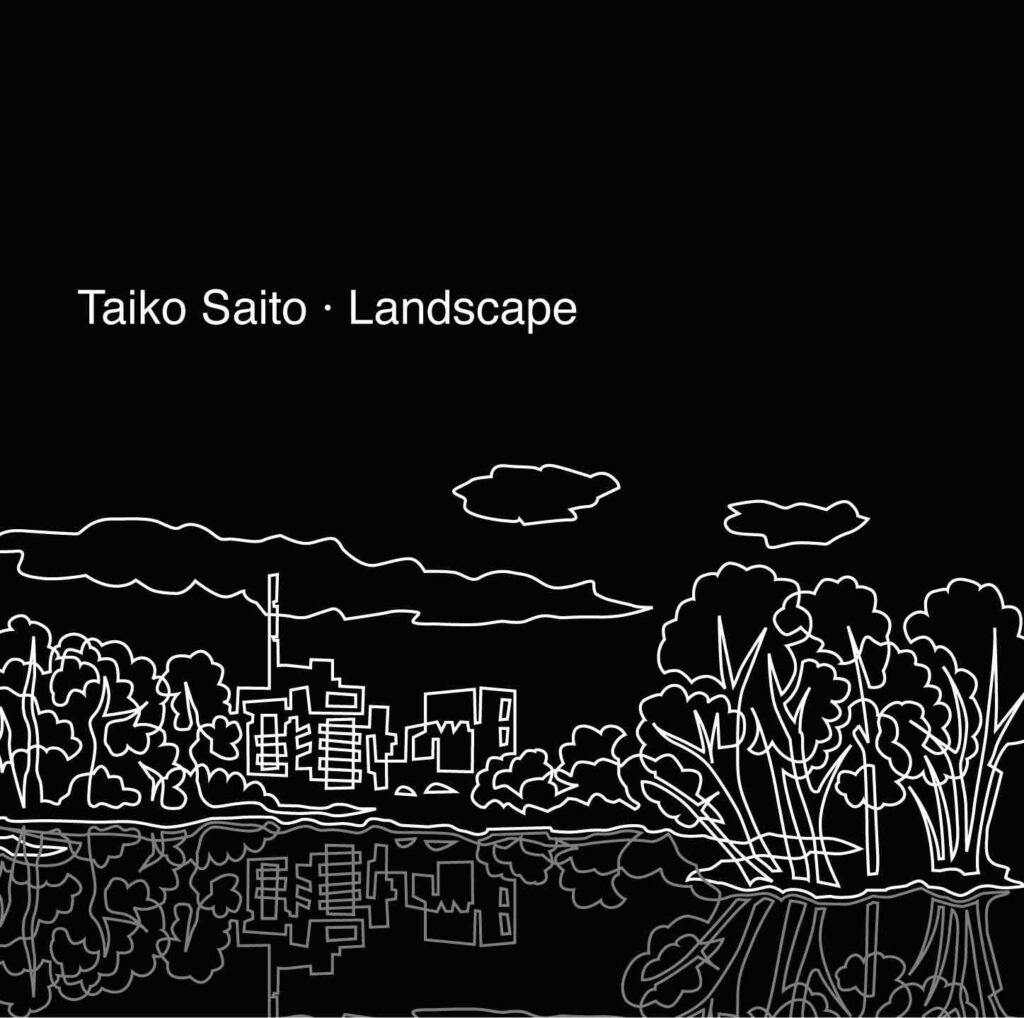Taiko Saito Solo
Marimba & Vibraphone

reviews:
Derk Richardson, The absolute sound
Saito’s genius… expounding upon repeated melodic and rhythmic motifs; experimenting with the rosewood tones of her 5.5-octave marimba. the motor- and pedal-driven reverberations and resonances of her vibraphone, and the percussive qualities of her 10 hand-wound mallets (plus the scrape and drone of a double bass bow on one track); and freely improvising from an “empty mind” starting point. Her titles- “Rain,” “Angry Bee,” “Sound Gradation,” “Uneri” (undulation)- evoke the swirling music she creates in three- to six-and-a-half-minute journeys through dreamlike soundscapes.
Toon Traveller, outside left
Let’s begin with Daichi the opening track on Taiko Saito’s new solo LP, Tears of a Cloud. Wow! What a way to begin a record. This is an LP that many readers might overlook, there’s no electricity, no bass line, nor a western melody. Improv rages sanguinely here. If you don’t listen then that is a serious loss my friends, ‘Tears of a Cloud’ has evocation, magic, and a breath-holding spirituality. It tantalises, flits, flirtatiously pollinating ideas, images, and emotions. Firework imagination, bright burning, explosives, illuminating in flashes of dexterous brilliance. This is music that shouts – softly, and sews ideas vigorously into the fertile grounds of our minds. The fast flurries, pensive pauses, delicate diminutive playing, demonstrate a master of her instrument with the highest power.
This whole LP is a joyously extravagant concoction. Celebratory. Suddenly calming. This is music that is just, a composer, an instrument, ideas, and the exquisite skill to demonstrate those thoughts, images, hopes, and directions. This music lives and breathes, like life itself. As the music grows and fills the spaces between idle moments and thoughts, you’re perhaps realising, just let this music fill small thin spaces with micro-moments of escape, into the beauties of your own contented, contemplative places. This is a brilliant record, seek it out.
Andy Hamilton, The Wire
Taiko Saito plays a variety of marimbas and vibraphones, creating lyrical, spacious and spiritual music. She plays solo, exploiting the contrast between these percussion instruments very effectively and sympathetically….. A beautiful and compelling recording.
Keith Black, Winnipeg free press
….She is clearly gifted and an explorer of the instrumental limits of vibraphone and marimba.
Dee Dee McNeil, Musicalmemoirs
Taiko Saito is a female marimba and vibraphonist who stretches music, like a rubber band across space. She offers the universe her solo excursion into complex compositions and free improvisation to display her talent like a banner across the sky. ….Here is an album that will prod your inner imagination and will also relax you like a musical massage. Taiko Saito’s music may inspire you, as it has this journalist, and like the composer herself, open your heart and your brain to endless possibilities.
Ivan Rod
Taiko Saito is an innovative, technically skilled and highly productive Japanese composer and marimba and vibraphone player.From her residence in Berlin, she has taken the initiative for a number of music projects and accepted others’, but I myself find the most pleasure in her own solo projects – e.g.in an album like the new one,Tears of a Cloud. And I do so because her sense of timbre appears so clear, her virtuosity so clear, her performance so naked. To a large extent, the music on the album is improvised, but one senses a connection to Japanese tradition, meditation, etc. Her sound and prefer red timbre are personal, significant, sensual. And it is a quality that requires a part of the practitioner.I especially admire her ability to dose and hold back.It is precisely this ability that makes her music so magnetic, so physical, so characteristic. At no point does she pander to the listener, and yet there is an immediate attraction in her improvisational music, which, with few exceptions, balances between avant-garde jazz and traditionalJapanese aesthetics.When I hear the track,Angry Bird, however, I involuntarily think of Nikolai Rimsky-Korsakov’s Flight of the Bumblebee.When I hear the closing track, Distance, I feel exposed to a wistful farewell.
Franpi Barriaux, Citizen Jazz
…Saito’s style: sensitive to the elements and accustomed to silence, a piece like ‘Sound Gradation’ is a real plunge into the instrument.
With Tears of a Cloud, Taiko Saito offers a panorama of her wide-ranging solo approach. ‘Uneri’ [1] is a perfect example, with its crystalline approach to the vibraphone and its rich, precise rhythmic work. With ‘Rain’, we return to what she proposed in Futari: a highly poetic work, inspired by the environment and transformed into a dreamlike reading represented by ‘Tears of a Cloud’, its metaphorical translation, built around a worked echo where simplicity is the order of the day. Taiko Saito’s mastery needs no virtuosity to impose a highly personal universe, never lacking in energy, as on ‘Angry Bee’. His mallets capture the zeitgeist perfectly. Once again, Trouble in The East Records offers us a fine voyage.
Dan McClenaghan, All About Jazz
In 2021 Japanese-born, Berlin-based mallet virtuoso Taiko Saito received a well-deserved profile bump via her teaming with pianist Satoko Fujii in a duo tagged Futari, on Beyond and Underground. both on Libra Records. The marimba player & vibraphonist returns in 2023 with a solo outing, Tears Of A Cloud, an arresting follow-up to the Futari outings.
Saito has found the key to artistic success by taking a handful of inspirations—her mentors Prof. Keiko Abe and Prof. David Friedman, the compositions of Kenny Wheeler, traditional Japanese music, tea ceremony, ikebana, etc. She pulls in these orbiting influences and puts her art together to make her own sound. Uncompromising originality is the result.
Tears Of A Cloud is spacious music, deliberative and way off the beaten path, hinting at some form of nondenominational spirituality, a mallet religion which makes time stand still, full of unexpected textures, holy resonances and colors we have never heard or seen before. This is free jazz (more accurately perhaps free music), but it is an engaging experience which pushes the boundaries of expectations. She finds beautiful sounds with off- center, otherworldly, sometimes asymmetrical rhythms that gel into fragile structures which sound like the scaffoldings upon which our surreal dreams are built. Or they could be the soundtrack to her life. We all live inside our own movies; Saito’s movies—her soundtrack to that creative life—celebrate mystery, clarity of vision and rejection of blueprints and “best-laid plans” in favor of discovery and surprise combined with a wide-ranging sense of wonder.
Piercarlo Poggio, Audio review
….They are partial and forced ruminations, because the tracks must beconsidered as a whole, as it is not possible to eliminate the strong ties that unite them and make them acomposite of virtuosity at the highest levels, of instant experimentation and sometimes of strong andabstract lyricism. A journey into the future without giving up the present.
Rick Anderson, CD Hotlist
… The album opens with the abstract and nearly pointillistic “Daichi” and then shifts to a more minimalist mode on “Sound Gradation.” “Underground” finds her using extended techniques to create sounds that one would not normally associate with the marimba — which is always fun. This album would make a great addition to any library collection that supports either jazz or classical percussion curricula.
Phontas Troussas, diskoryxeion.blogspot
It is obvious from the beginning of the listening that a big part of the recording, if not all of it, is improvisational, something that, definitely, frees the Japanese musician, who, completely uninhibited, attempts to create from scratch this unique and strange environment (which she creates eventually), pulling the listener by the sleeve.
We say this, because “Tears of a Cloud” has a way of keeping you captivated by its evolution, trapping you in its completely bizarre sequence of tracks, and ultimately overwhelming you with its original and creative, largely, evolution.
Certainly, here, you can hear tracks that seem to exhaust the sonic possibilities of the two instruments, and you can perceive this in “Underground”, for example (where the Japanese woman uses bows and sticks, producing a hypochondriac sound, on the borderline of buzz and noise, with the “pure” sound of the sticks acting completely antithetical), of course in “Uneri” (with the reverberations creating a strange “dreamy” environment) or even in “Rain”, a piece which in a sense reflects a rainfall, which has different intensities, which is asymmetrical and which creates this erratic flow.
In general, every track of this album is something unique and special, without sounding, at the same time, “difficult” to the ear. There is a naturalness, we mean, to Taiko Saito’s music, without at any point lapsing into the mechanical and indifferent.
Jon Davis, expose.org
— she uses a wide variety of mallets and sticks, including ones she’s made herself, to elicit a wide variety of sounds, and she sometimes uses a bow to bring out eerie, ethereal tones. ….. there’s a sense of structure and consistency to the pieces, and each has its own identity. In short, Tears of a Cloud is a fascinating journey into the sonic possibilities of the marimba and vibraphone, and also an entertaining listen.
Tomáš S. Polívka, Jazz.rozhlas.cz
Albums for solo marimba or vibraphone are not very common. Moreover, the Japanese virtuoso player Taiko Saitō manages to fill the sound space in such an interesting way that perhaps the listener can only think of the symmetry of sound and poetry. The flowery, oriental one. “Tears of cloud” here not only evoke raindrops, but literally recite a story.
Vangelis Aragiannis, Jazzbuzz.gr
“Tears of a Cloud” (Trouble in the East Records) is her first solo marimba and vibraphone recording. To create it, she says she took three approaches: playing completely spontaneously, following and developing a pattern, or experimenting with the sound and characteristics of the instrument. This becomes clear right from the start to the ears of the listener, who realises from the first few minutes that this is a purely improvisational sound. The absence of a specific melodic theme and the permanently experimental mood, however, don’t tire, they don’t create a heavy environment, but on the contrary they keep the attention or rather they magnetize it, since Saito’s narration is layered, substantial and without chatter, with the tracks having an average duration of around 3 to 4 minutes. As in Brennan’s case, the reverberations of these two atmospheric instruments lead the senses into a mysterious, otherworldly environment full of unusual colours.
Release

Tears of a Cloud
Digital Album is now available!
Taiko Saito’s solo classical music project
compositions of David Friedman, her orginal and jazz standerd etc
